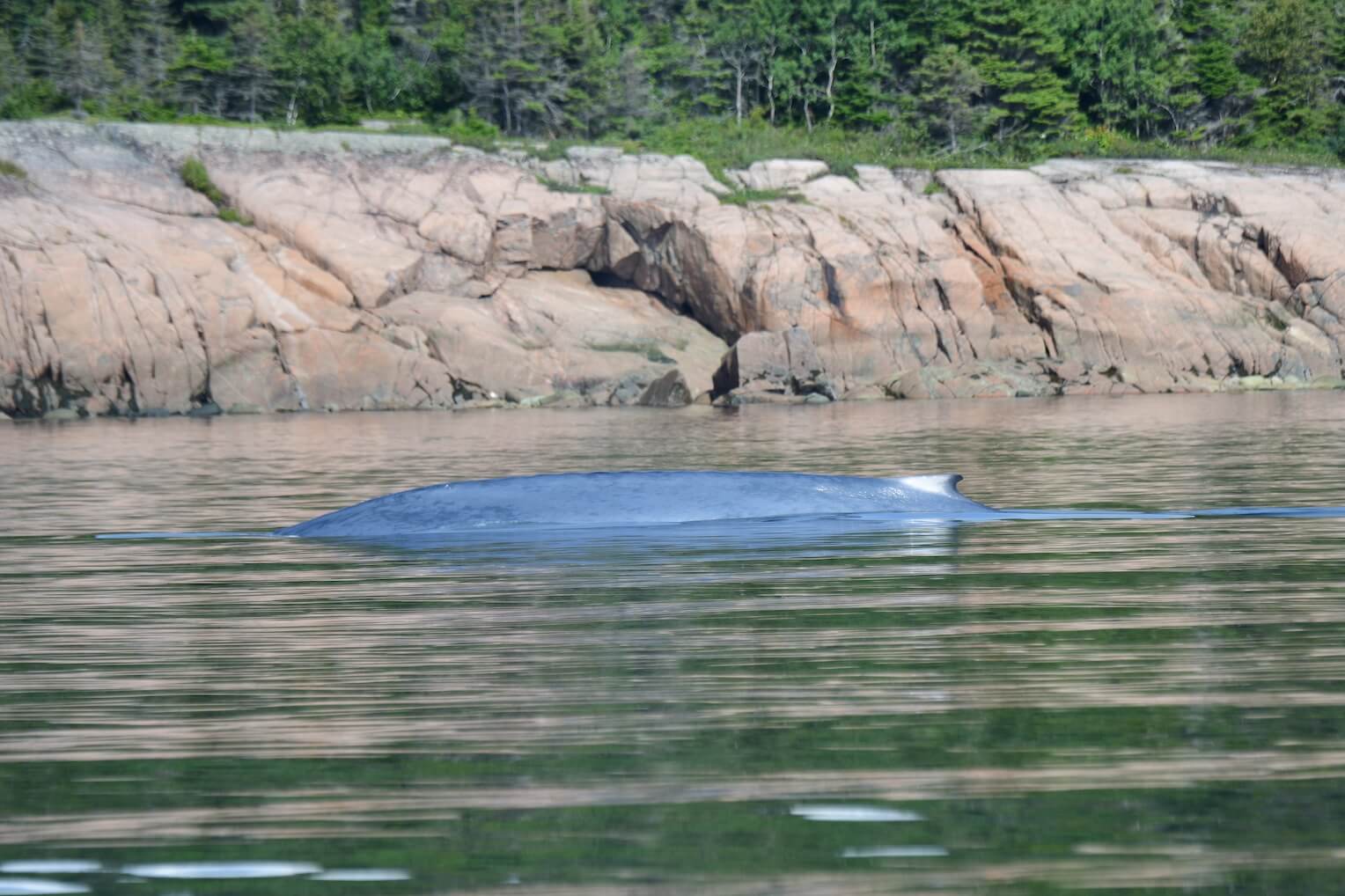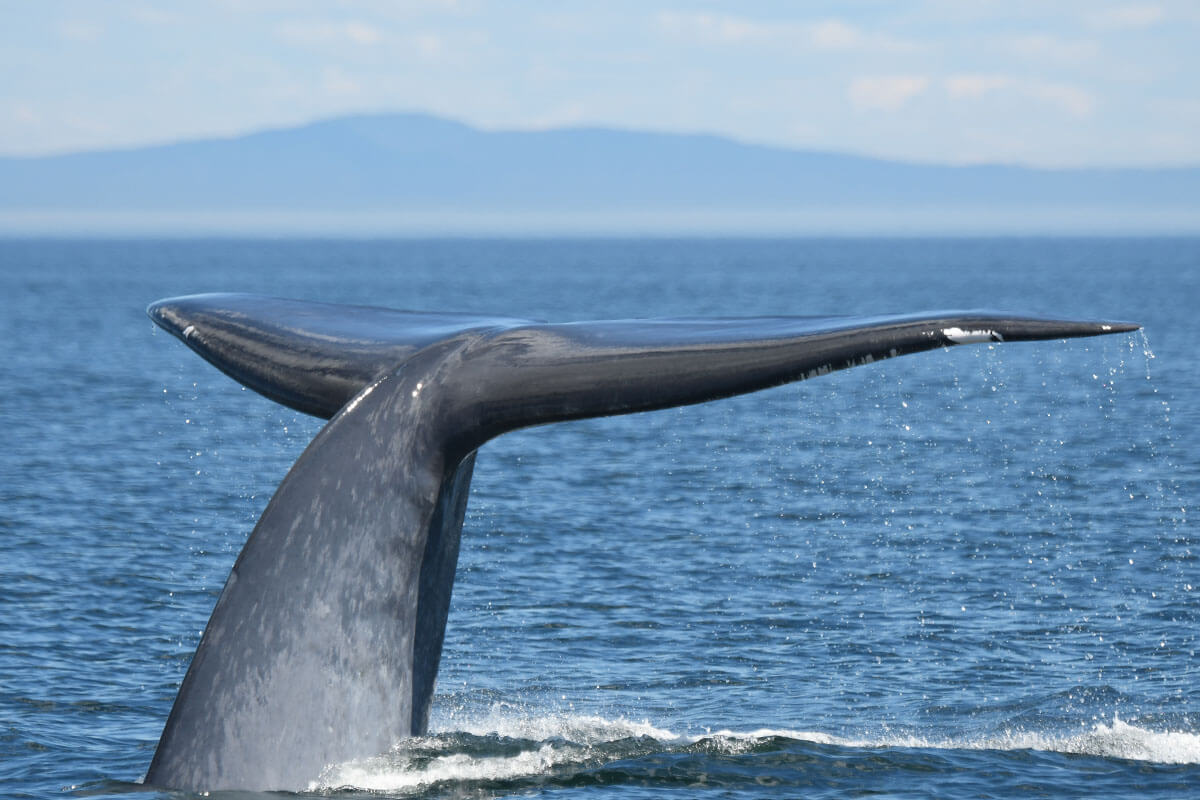Everyone was surprised this week when not one, but two endangered species ventured into the St. Lawrence Estuary: one North Atlantic right whale and two blue whales. What was even more astonishing was when the right whale wandered up the Saguenay Fjord and the blue whales were identified as a mother-calf pair.
Unusual stories
On Saturday, August 6, a North Atlantic right whale was spotted at the mouth of the Saguenay Fjord. The individual then swims up the fjord as far as Anse à la Boule before returning to the estuary that evening. A few well-informed observers were even able to watch it from shore at Pointe de l’Islet in Tadoussac. Most of them could barely contain their enthusiasm: “This was the first time I ever saw a right whale, says one cetacean enthusiast. You could clearly see its V-shaped spout, he explains. I was able to see it emerge above the surface a few times before it dived, which was quite impressive. Especially since it’s so rare to see them here!”
Photos of the animal have been sent to the North Atlantic Right Whale Consortium and, while it cannot be confirmed at this time, it may be a calf aged around one-and-a-half years old. The North Atlantic right whale is endangered, with an estimated population of fewer than 350 individuals. After centuries of whaling, the species is now a victim of entanglements and collisions with boats. In recent years, climate change also seems to be affecting the right whale’s habits. Four days after the first sighting, i.e. On Wednesday August 10, a right whale was spotted on the south shore of the St. Lawrence at L’Anse-au-Persil, between Rivière-du-Loup and Cacouna. Photo analysis will help determine whether this is the same animal observed earlier in the week or a different individual.
Concurrently, the presence of two blue whales was also reported off Cap de Bon-Désir, between Les Bergeronnes and Les Escoumins. The individuals were identified as B246, a female known since 1991 and nicknamed “Jaw-Breaker [DA1] ,”and a first-year calf. Jaw-Breaker is one of the blue whales that shows her tail when she dives. She can be recognized by her particularly white dorsal fin and the colour pattern of her back. According to Richard Sears, president of the Mingan Island Cetacean Study [DA2] (MICS), this is likely her second confirmed calf, as she is believed to have had one 4 years ago. Additionally, this would be just the 35th mother-calf pair identified in the St. Lawrence River in 44 years.
Exciting observations
Elsewhere in the St. Lawrence, there are plenty more marine mammal sightings. For the MICS team working in the Mingan Archipelago on August 9, the day in the field ended with the observation of several marine mammals. They share their excitement on the social networks: “After a rather calm start to the season, yesterday our team of scientists spotted no fewer than 6 humpbacks, 3 minke whales, 2 fin whales and our first blue whale of the year! While some of us stayed at the station today to process collected data and welcome visitors to the museum,we hope that those who do make it out to sea will enjoy other great encounters.”
A recreational boater also relates her observations in the Mingan sector: “minke whales, porpoises, harbour seals, grey seals and, most likely, dolphins.” Farther up river, in Sept-Îles, minke whales swim along the coast and tuna are seen leaping out of the water, not to mention foraging grey seals. In Franquelin, a few humpbacks, many minke whales and good numbers of harbour porpoises are observed. In Tadoussac, an amalgam of marine mammals were spotted throughout the week, including humpbacks, minke whales, seals, belugas and harbour porpoises.
After paddling down the north shore of the Saguenay from L’Anse-de-Roche toward Baie-Sainte-Catherine, a kayaker shares her encounter with seals: “We came across a group of 6 harbour seals. They were lying on the rocks like bananas. There was also a pair of seals surrounded by cormorants drying their wings. They were intrigued to see us, but we kept our distance so as not to scare them.”
From the Gaspé Peninsula, white-sided dolphins, seals, harbour porpoises, minke whales and a few humpbacks have all been reported. In Gaspé Bay, humpback whales slap their huge pectoral fins on the water surface to the delight of observers, who are blown away by this majestic animal.
Map of the observations of the week
Here is the map of observations reported this week. It gives an idea of the presence of whales and does not at all represent the actual distribution of whales in the St. Lawrence. Use it for fun!
A tightly knit network of experienced observers who live according to the rhythm of the St. Lawrence throughout the year. On the waves or on shore, they scan the horizon with passion and patience, watching for the slightest spout. It is thanks to their sharp eyes and living words that we are able to write News from Afield week in and week out. A big thank you to all of our precious collaborators!
Click on the whale or the seal icon to find out more about the corresponding observation (species, number of individuals, info, pictures). To enlarge the map, click on the top right corner icon.
Vous souhaitez partager vos observations et contribuer à la science citoyenne? Utiliser l’outil de saisie d’observations de mammifères marins.








